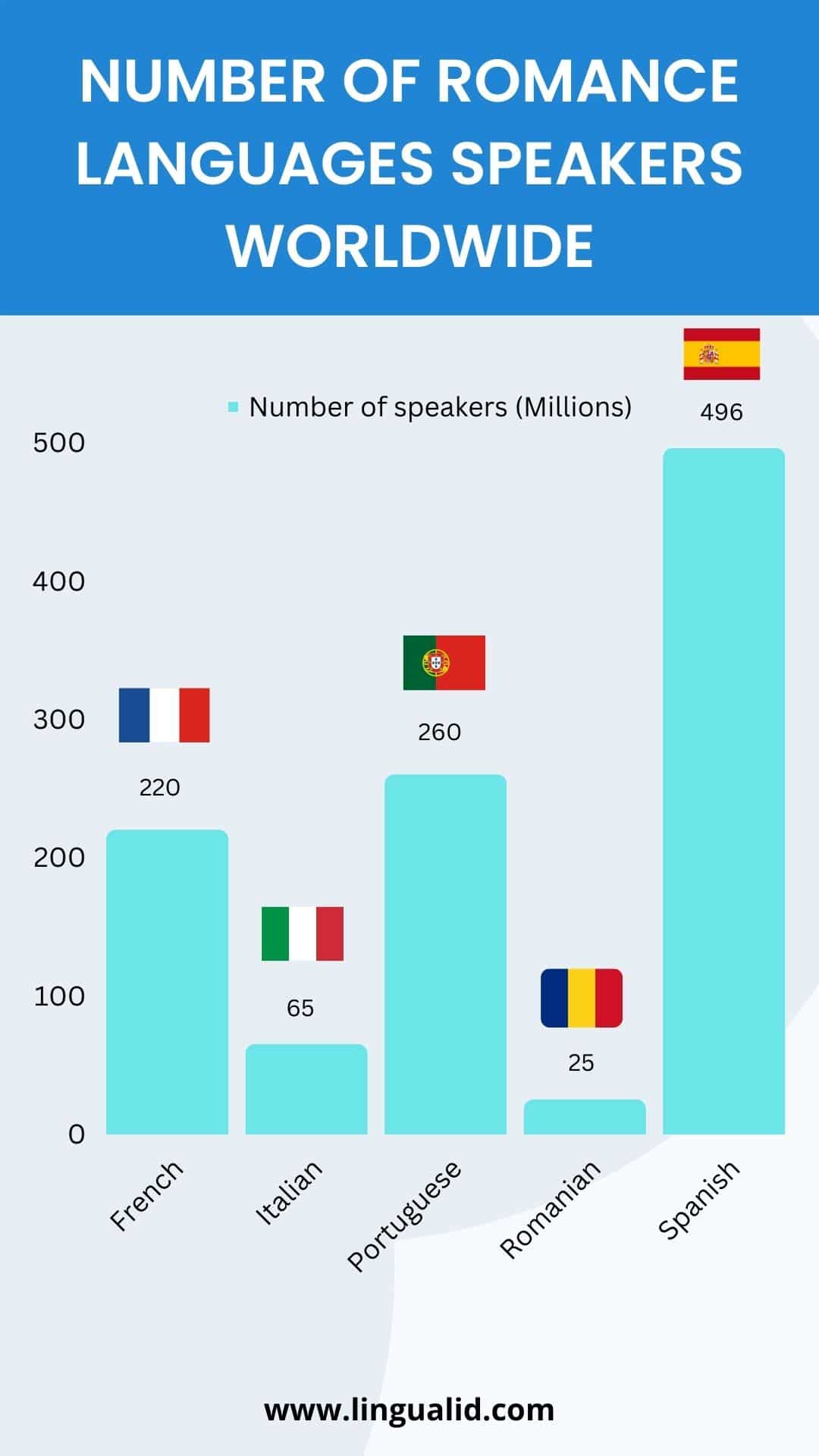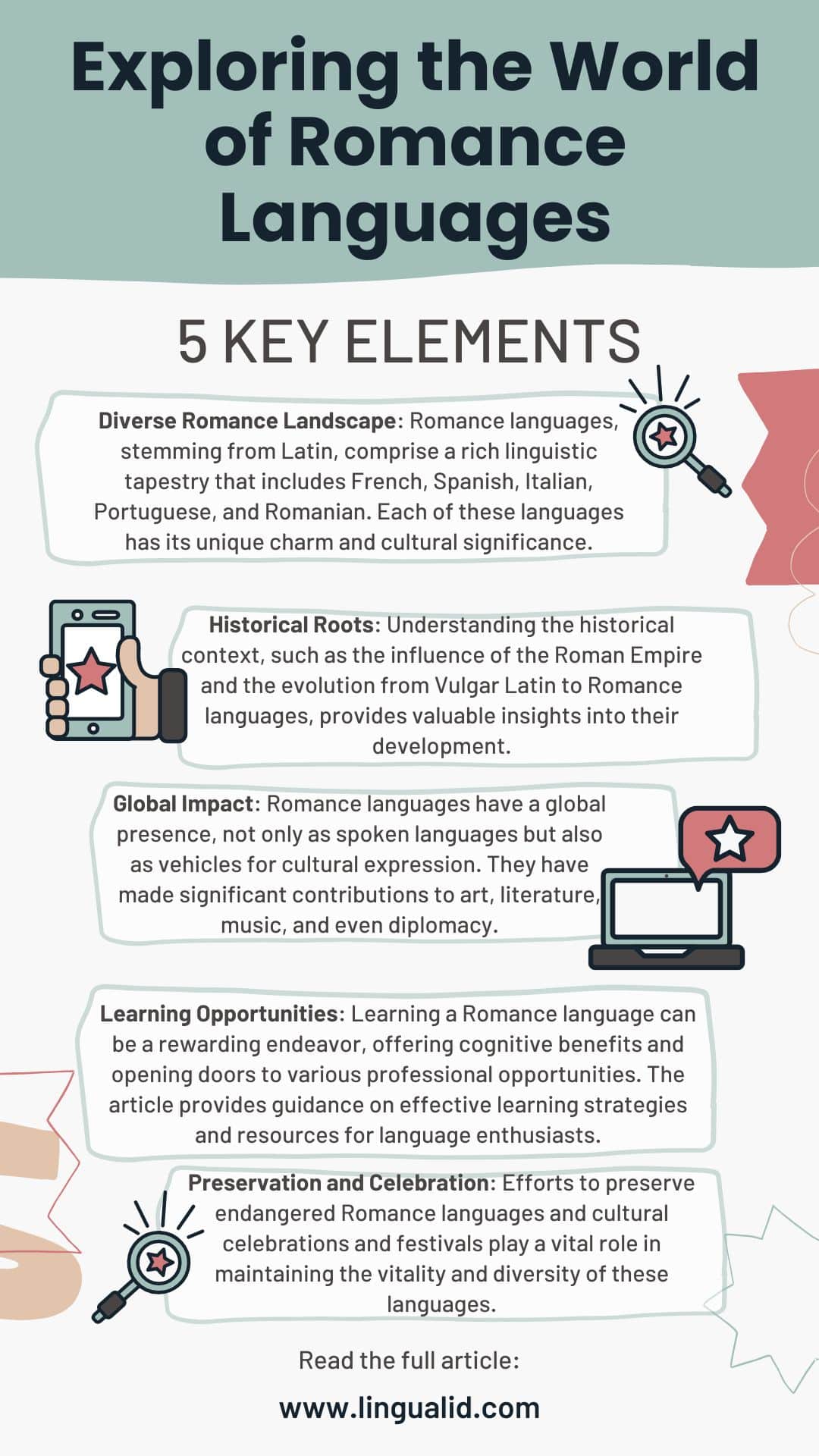Introduction
Romance languages have long captivated linguists, historians, and enthusiasts alike with their melodious rhythms and rich cultural heritage. In this article, we embark on a journey through the fascinating world of Romance languages, exploring their origins, diversity, and enduring influence on modern society. Let’s get started!
- Introduction
- Chapter 1: The Origins of Romance Languages
- Chapter 2: The Diverse World of Romance Languages
- Chapter 3: The Influence of Romance Languages
- Chapter 4: Learning Romance Languages
- Chapter 5: Can speakers of Romance languages understand each other?
- Chapter 6: The influence of other languages on Romance languages
- Conclusion
Key Takeaways:
- Diverse Romance Landscape: Romance languages, stemming from Latin, comprise a rich linguistic tapestry that includes French, Spanish, Italian, Portuguese, and Romanian. Each of these languages has its unique charm and cultural significance.
- Historical Roots: Understanding the historical context, such as the influence of the Roman Empire and the evolution from Vulgar Latin to Romance languages, provides valuable insights into their development.
- Global Impact: Romance languages have a global presence, not only as spoken languages but also as vehicles for cultural expression. They have made significant contributions to art, literature, music, and even diplomacy.
- Learning Opportunities: Learning a Romance language can be a rewarding endeavor, offering cognitive benefits and opening doors to various professional opportunities. The article provides guidance on effective learning strategies and resources for language enthusiasts.
- Preservation and Celebration: Efforts to preserve endangered Romance languages and cultural celebrations and festivals play a vital role in maintaining the vitality and diversity of these languages.
In the world of linguistics, Romance languages stand as a testament to the enduring beauty of human expression. Whether you’re an aspiring polyglot, a history enthusiast, or simply someone intrigued by the magic of words, exploring these languages is an enriching endeavor that promises to ignite your passion for linguistics.
Chapter 1: The Origins of Romance Languages
1.1. Tracing the Roots: Latin’s Legacy
Latin, the language of the ancient Romans, serves as the common ancestor of all Romance languages. Its influence can be seen in vocabulary, grammar, and syntax. As the Roman Empire expanded, Latin evolved into numerous dialects, laying the foundation for the diverse set of languages we now refer to as Romance.
1.2. Language Evolution: From Vulgar Latin to Romance
The transition from Latin to Romance languages wasn’t abrupt but a gradual process. Vulgar Latin, spoken by common people, evolved differently across regions, giving rise to distinct linguistic identities. This evolution was influenced by local languages and cultures, creating the rich tapestry of Romance tongues we have today.
1.3. Historical Context: The Role of the Roman Empire
The Roman Empire’s dominion over vast territories facilitated the spread of Latin. As Roman legions conquered new lands, Latin was introduced and absorbed, leaving an indelible mark on the linguistic landscape. The fall of the Western Roman Empire did not diminish Latin’s influence; instead, it led to further diversification.
Chapter 2: The Diverse World of Romance Languages
2.1. French: The Language of Love
French, often regarded as the “Language of Love,” is primarily spoken in France, where it is the official language. However, its influence extends far beyond the borders of France. French is also widely spoken in several countries across Europe, including Belgium, Switzerland, Luxembourg, and Monaco. Moreover, it serves as an official language in numerous African nations, due to their historical ties with France. With approximately 220 million speakers worldwide, French ranks as one of the most widely spoken languages globally and plays a significant role in diplomacy, culture, and international affairs
2.2. Spanish: A Global Phenomenon
Spanish, a global linguistic phenomenon, is primarily spoken in Spain, where it is the official language. However, its influence reaches well beyond the Iberian Peninsula. Spanish is the second most spoken language in the world, with approximately 496 million native speakers. It is widely spoken in Latin America, where countries like Mexico, Argentina, and Colombia have sizable Spanish-speaking populations. Additionally, Spanish holds official status in several countries across the Americas, making it a key language for international business, trade, and cultural exchange. With its rich cultural heritage and extensive reach, Spanish continues to captivate and connect people across the globe.
Related: The World Of Spanish Dialects
2.3. Italian: Beyond Pasta and Pizza
Italian, known for its musicality and cultural significance, is primarily spoken in Italy, where it serves as the official language. Italy, with its rich history and art, is the heartland of the Italian language. Beyond Italy’s borders, Italian is spoken in Switzerland, where it holds official status in the canton of Ticino, as well as in some regions of Istria in Croatia and in parts of Slovenia. It’s also spoken by Italian communities around the world, particularly in the United States and Argentina. With approximately 65 million native speakers, Italian may not be as widely spoken as some other Romance languages, but its cultural importance, exquisite artistry, and contributions to music, fashion, and cuisine make it a beloved and influential language worldwide.
2.4. Portuguese: A Lusophone Marvel
Portuguese, often described as a Lusophone marvel, is primarily spoken in Portugal, where it is the official language. However, its influence extends far beyond the Iberian Peninsula. Portuguese is the official language of Brazil, where it boasts the majority of its speakers, totaling over 200 million native speakers. It is also spoken in several African nations, including Angola, Mozambique, and Cape Verde, due to historical colonial ties. Portuguese is known for its lyrical quality and plays a vital role in fostering cultural connections among the diverse Portuguese-speaking communities across the globe. With approximately 260 million speakers worldwide, Portuguese is a language of global significance and influence.
Related: Discover The Different Portuguese Dialects Around The World
2.5. Romanian: A Unique Eastern Flavor
Romanian, a unique Eastern-flavored Romance language, is primarily spoken in Romania, where it serves as the official language. It’s also one of the official languages of Moldova, a neighboring country. While it shares its Latin roots with other Romance languages, Romanian has distinct influences from Slavic and other Eastern European languages, giving it a unique linguistic flavor. With around 25 million speakers worldwide, Romanian may not have the extensive global reach of some other Romance languages, but its rich cultural heritage and historical significance make it a fascinating linguistic gem in the heart of Eastern Europe.

Chapter 3: The Influence of Romance Languages
3.1. Cultural Impact: Art, Music, and Literature
The Romance languages have been instrumental in shaping the world of arts. From Dante’s “Divine Comedy” in Italian to Cervantes’ “Don Quixote” in Spanish, these languages have produced masterpieces that continue to inspire and captivate.
3.2. Linguistic Legacy: Borrowed Words and Phrases
Romance languages have lent their words and phrases to countless other languages. From legal terminology to everyday words, these linguistic contributions enrich communication across the globe.
3.3. Global Communication: The Role in Diplomacy
French and Spanish have historically played pivotal roles in diplomacy. They are official languages of international organizations like the United Nations, showcasing their importance in global communication.
Chapter 4: Learning Romance Languages
4.1. Benefits of Learning Romance Languages
Learning a Romance language offers cognitive benefits such as improved memory and multitasking skills. Additionally, it opens doors to exciting job opportunities, especially in international business and tourism.
4.2. Effective Learning Strategies
Mastering a new language can be challenging, but effective strategies, such as immersive experiences, language exchange programs, and online resources, can make the journey enjoyable and successful.
4.3. Resources for Language Enthusiasts
For those eager to embark on the journey of learning a Romance language, there is no shortage of resources. Books, online courses, language apps, and local language schools provide ample options for learners of all levels.
Related: Visit our resources page to learn more.
4.4. Learn Romance Languages with Lingualid
Experience the joy of mastering French, Spanish, and Portuguese all in one place with us at Lingualid. Whether you’re a busy professional, a student, or a language enthusiast, our courses will empower you to become a confident speaker. Don’t miss your chance to embark on a linguistic adventure today! Join us and open doors to a world of multilingual possibilities.
Your journey starts now, become a part of the Lingualid family, where language learning knows no bounds!
Chapter 5: Can speakers of Romance languages understand each other?
The degree of mutual intelligibility among speakers of Romance languages varies significantly, influenced by factors such as linguistic similarities, exposure to other Romance languages, and regional dialects. Generally, speakers of closely related Romance languages, such as Spanish and Portuguese, or Italian and Spanish, may find it relatively easier to understand each other due to shared vocabulary and grammatical structures.
However, as you move further apart on the Romance language spectrum, like comparing French and Romanian, mutual intelligibility decreases. Regional dialects within each language can also present challenges; for example, the difference between European Portuguese and Brazilian Portuguese can be notable.
While the Romance languages share a common Latin heritage, the diversity and evolution of these languages over time have led to distinct identities, making full mutual intelligibility a complex and nuanced matter. Nevertheless, language enthusiasts often find joy in recognizing similarities and connections when encountering other Romance languages.

Chapter 6: The influence of other languages on Romance languages
The influence of other languages on Romance languages is a fascinating aspect of their evolution. While Romance languages have their roots in Latin, they have been significantly shaped by interactions with other languages and cultures throughout history. Here are some notable influences:
Germanic Influence: During the migration period in Europe, Germanic tribes influenced Romance languages through contact. Words related to governance, trade, and everyday life found their way into languages like French and Spanish. For example, in English, “guardian” and in Spanish “guardián” both have Germanic origins.
Arabic Influence: Arabic has a substantial influence on Spanish and Portuguese. Many words related to science, mathematics, and technology, such as “algebra” and “zero,” have Arabic roots.
Celtic Influence: In regions where Celtic languages were spoken, such as Brittany in France, Celtic languages contributed words and cultural elements to the local Romance languages.
African Influence: In former African colonies, local African languages and dialects have influenced the vocabulary and pronunciation of French and Spanish.
Native American Influence: In Latin American countries, indigenous languages like Nahuatl, Quechua, and Guarani have contributed words related to flora, fauna, and everyday life to Spanish and Portuguese.
English Influence: Modern Romance languages have also incorporated English words, especially in the context of technology, pop culture, and business.
These influences have enriched Romance languages, making them dynamic and adaptable. They showcase the interconnectedness of languages and the cultural diversity that has contributed to their development over the centuries.
Conclusion
Romance languages are more than just modes of communication; they are windows into the rich and diverse cultures of the world. These languages connect us to our past, enrich our present, and inspire our future, making them an invaluable part of our global heritage.
So, why wait? Dive into the linguistic romance of Romance languages, and let their beauty and history captivate your senses and intellect. Embrace the world of linguistic diversity, and you’ll discover a new appreciation for the power and elegance of human communication.
Oualid Cheddadi is a language enthusiast who created Lingualid with the mission to inspire independent language learners worldwide, regardless of the language they are learning. The name “Lingualid” is derived from the Portuguese word for “language,” “língua,” and the last three letters of Oualid’s name, “Lid.”
